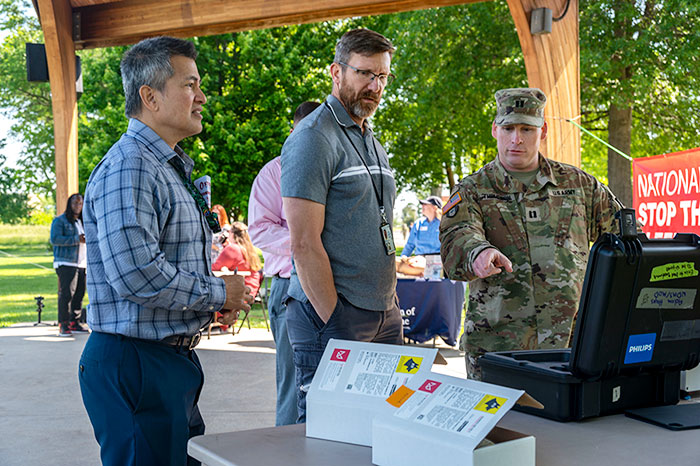USAMMDA team supports STOP THE BLEED®

Team members with U.S. Army Medical Materiel Development Activity supported the National STOP THE BLEED® Day event sponsored by the U.S. Army Research and Development Command, May 25, Fort Detrick, Maryland.
The U.S. Department of Defense's STOP THE BLEED® program is a public health campaign designed to train and equip private citizens to save the lives of people who have suffered a traumatic injury involving severe blood loss, according to stopthebleedcoalition.org.
During the event, three dozen event attendees learned about traumatic hemorrhages and participated in hands-on training led by emergency responders and medical subject matter experts. As the STOP THE BLEED® name suggests, attendees learned how to recognize, respond, and treat hemorrhage wounds. The training is a 90-minute course that helps trainees learn a lifelong skillset currently used by military medical providers and first responders.
"STOP THE BLEED® is a great way for our team to reach out and provide tangible support to members of both the military and civilian communities," said Austin Langdon, a program manager with the USAMMDA Warfighter Deployed Medical Systems Project Management Office. "As a former flight medic who supported the Marines in Helmand Province, Afghanistan in 2012, I have seen firsthand how critical hemorrhage control is to patient survival outcomes. This training enables civilians to get the foundational knowledge necessary to make a difference when confronted with unexpected traumatic events."
USAMMDA is the U.S. Army's premier medical capabilities developer for the U.S. Joint Forces. As development experts from across the spectrum of combat casualty care, team members with USAMMDA have a unique understanding of the history of combat related hemorrhages, the effects of hemorrhaging combat wounds, and how to treat those wounds to help preserve lives, said Langdon.
"The USAMMDA team is uniquely suited to support events like STOP THE BLEED®," said Langdon. "We have a wealth of knowledge and expertise in understanding the urgency of traumatic hemorrhage control and the skills and methods anyone can use to respond if someone is injured or wounded. It is an honor to represent USAMMDA and everyone on my team for a program that has a widespread impact that enables people to save their own life, a stranger or a loved one."
There is a significant focus within the Department of Defense medical development enterprise on finding solutions to treat traumatic hemorrhage, for both human and canine members of the Joint Force. USAMMDA is working to develop blood product solutions for use by frontline medical providers as far forward and as close to the point of injury as possible. The goal is to create and provide solutions to frontline medics, corpsmen, and medical officers to preserve patient lives until medical evacuation to higher echelons of care is arranged, according to Sgt. 1st Class Hunter Black, USAMMDA's senior enlisted medical advisor.
"This type of training is a reflection of the importance medical providers in uniform place on the efforts to control bleeding," said Black. "In combat, the quicker bleeding is controlled, and the faster blood is replaced with whole blood or plasma products, the better chance of survival a patient has. In combat and during emergencies at home in the community, every minute counts. This type of training helps increase those minutes and hopefully help save lives."













